The rituals at Lord Jagannath’s temple reflect the grandeur of the supreme deity. These rituals, referred to as ‘Niti’, are categorised into daily, occasional, and festive.
Around 85-90 servitors are engaged in these complex and highly structured rituals. Each servitor has a specific role, with duties and times pre-determined.
The daily nitis begin around 5am and continue late into the night. While time variations occur due to practical reasons, especially on festive days when additional rituals are performed, the daily routine remains largely intact.
Here is the list comprising 20 daily rituals of the Holy Trinity at Puri temple.
1. Dwaraphita
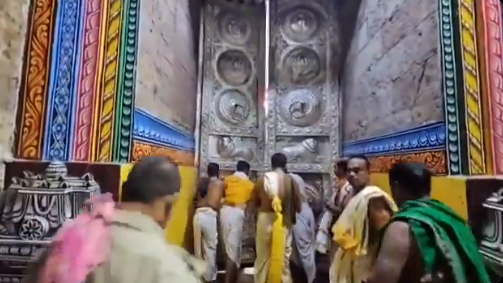
The first ritual, known as Dwaraphita, marks the opening of the temple doors early in the morning. According to the temple’s Record of Rights, the doors of the sanctum should be opened by 4:30am. This process requires the presence of five sevakas: Bhitarchha Mahapatra, Pratihari, Muduli, Akhanda Mekap, and Palia Mekap. The Bhitarchha Mahapatra examines the seal placed on the padlock by Talichha Mahapatra the previous night. If the seal is intact, Bhitarchha Mahapatra breaks the seal, unlocks the door, and opens it. The same procedure is followed for opening the door to the inner sanctum, known as the Kalahat Dwara.
2. Mangala Alati
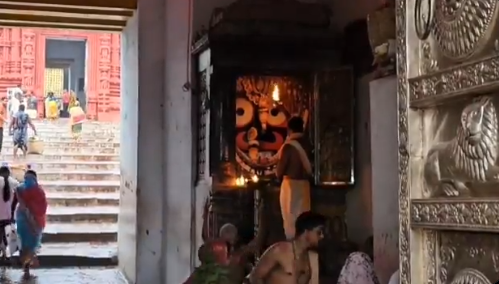
Following the Dwaraphita ritual, Mangala Alati takes place at approximately 5:30am. This offering of sacred lamps is performed by Bhitarchha Mahapatra, assisted by two other Puspalaka servitors. They stand below the Ratnasinghashan (the pedestal where the deities are placed) to perform the ritual. There are three different types of Alati performed: Karpura Alati, Bati Alati, and Pithau Alati, each with specific offerings and significance.
Also Read: 10 must-try sweets from Odisha
3. Mailam
Mailam, scheduled for 6am, involves replacing the previous night’s garments and floral decorations from the deities. After the Mangala Alati, the garments worn by the deities are changed, and the flowers used in the previous night’s adornment are removed. The deities are then clothed in simple cotton garments known as Tadap and Uttariya, which prepare them for the subsequent ritual of Abakash, which involves the cleaning of teeth and bathing.
4. Abakasha
The Abakasha ritual begins at 6:30am and is a crucial daily ritual for Lord Jagannath and His Siblings. It involves a group of servitors, including Bhitarchha, Palia Puspalakas, Suarbadu, Paniapata, Mukhapakhala, Pratihari, Chatuary, Bhandar Mekap, Mahabhoi, and the temple astrologer, Khuri Nayak. During this ritual, the servitors clean the teeth of the deities using brass mirrors, which reflect the images of the deities. The deities are then bathed with water mixed with camphor, curd, amla, sandal paste, and fragrant flowers. The temple astrologer, known as the Jyotisha, reads out the tithi (lunar date) and other astrological details of the day. The puja during this ritual is performed using Pancha Upachara (five prescribed offerings).
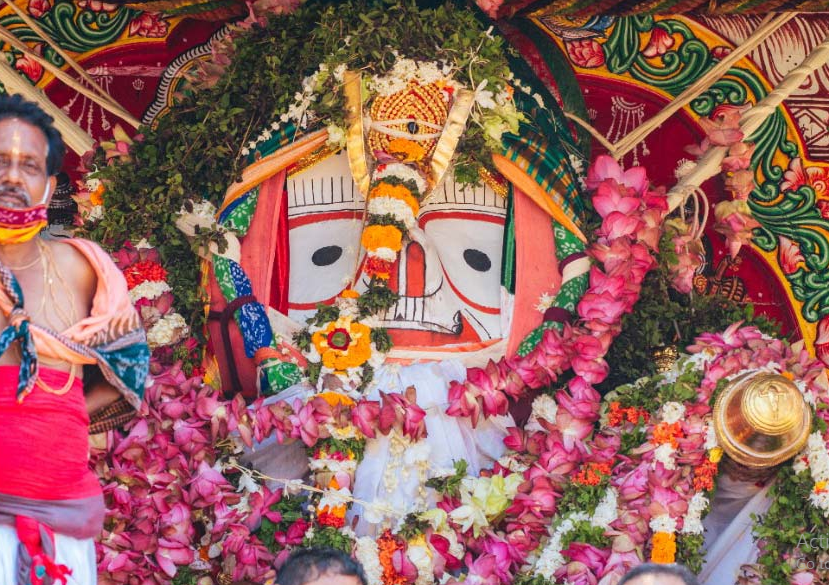
5. Mailam, Beshalagi
Once the bathing rituals are completed, the deities are dressed in fresh clothes. This is known as Beshalagi, where the deities are adorned with new clothes, floral ornaments, and garlands. The servitors responsible for this ritual include the Puspalaka, Changada Mekap, Akhanda Mekap, Suarbadu, and Khuntia, who work together to ensure the deities are properly dressed and prepared for the next niti.
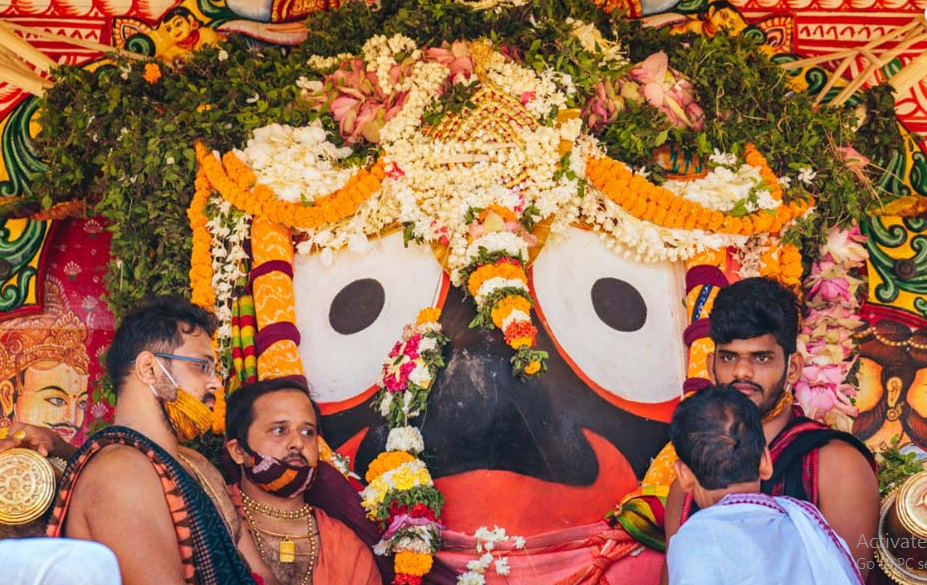
6. Rosha Homa
Before the cooking for the Lord begins, a sacred fire is lit which is also known as Rosha Homa. It is performed in the temple kitchen. This ritual is carried out by the Puja Panda servitors to purify the kitchen and bless the food that will be prepared for the deities.
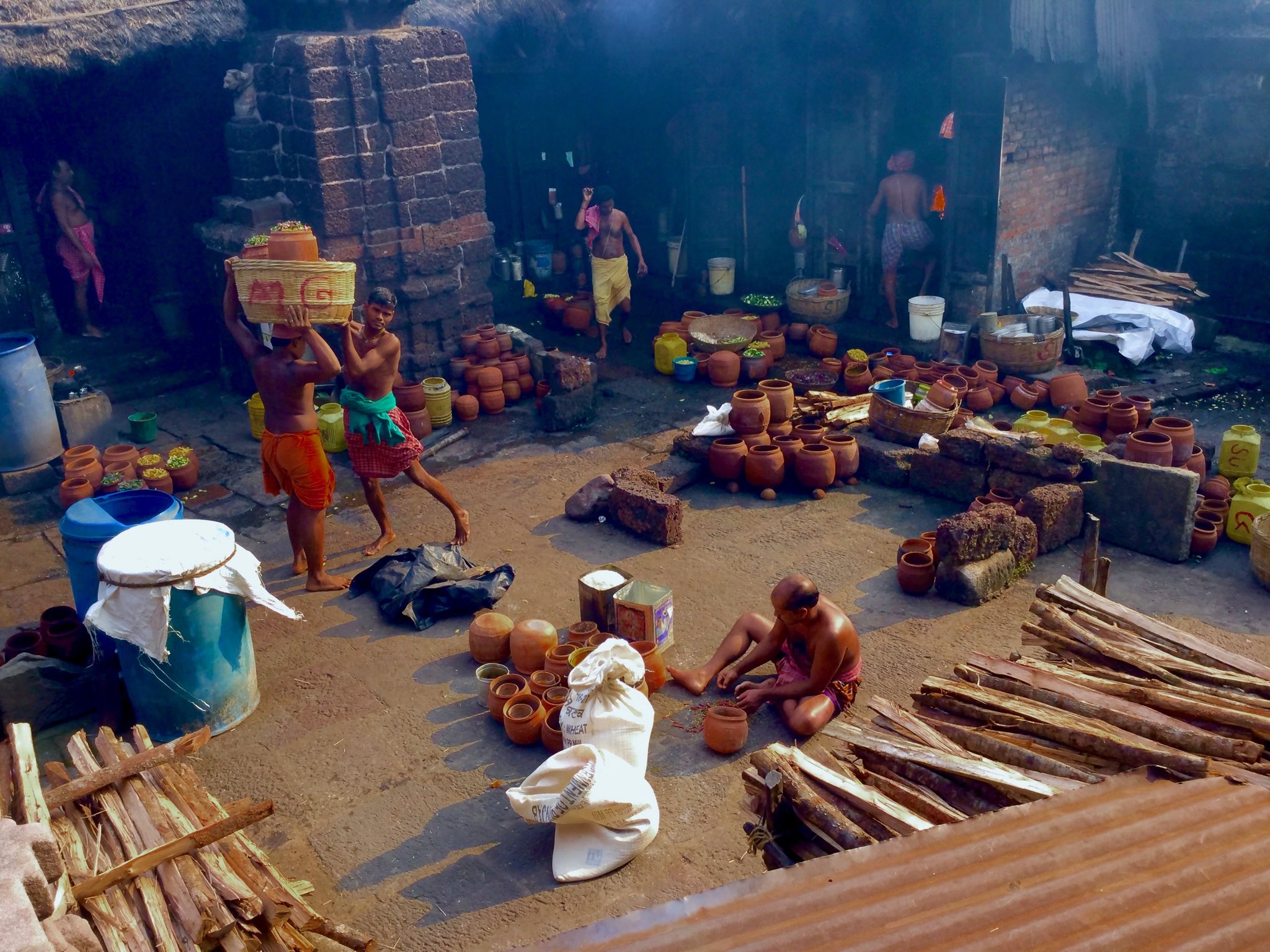
7. Surya Puja
At 7:45am, the next ritual is Surya Puja, where worship is offered to the Sun God. This takes place within the inner enclosure of the temple, near the Muktimandap, and is performed by a Pujapanda sevaka.
8. Dwarapala Puja
Following the Surya Puja, the Dwarapala Puja is performed at the Jaya Vijaya gate of the main temple. This ritual is also conducted by a Pujapanda sevaka and involves offering prayers to the temple’s gatekeepers.
9. Gopal Ballav Bhoga
At 8:30am, the deities are offered their first meal of the day, known as Gopal Ballav Bhoga. This offering, considered a light breakfast, includes coconut sweets, fruits, sweet popcorn (khai), ripe bananas, curd, chipped coconut, and green coconut. This ritual is performed by three Pujapanda servitors at the Anasara Pindi (Ballava Pindi), located between the Kalahat door and the first wooden door.
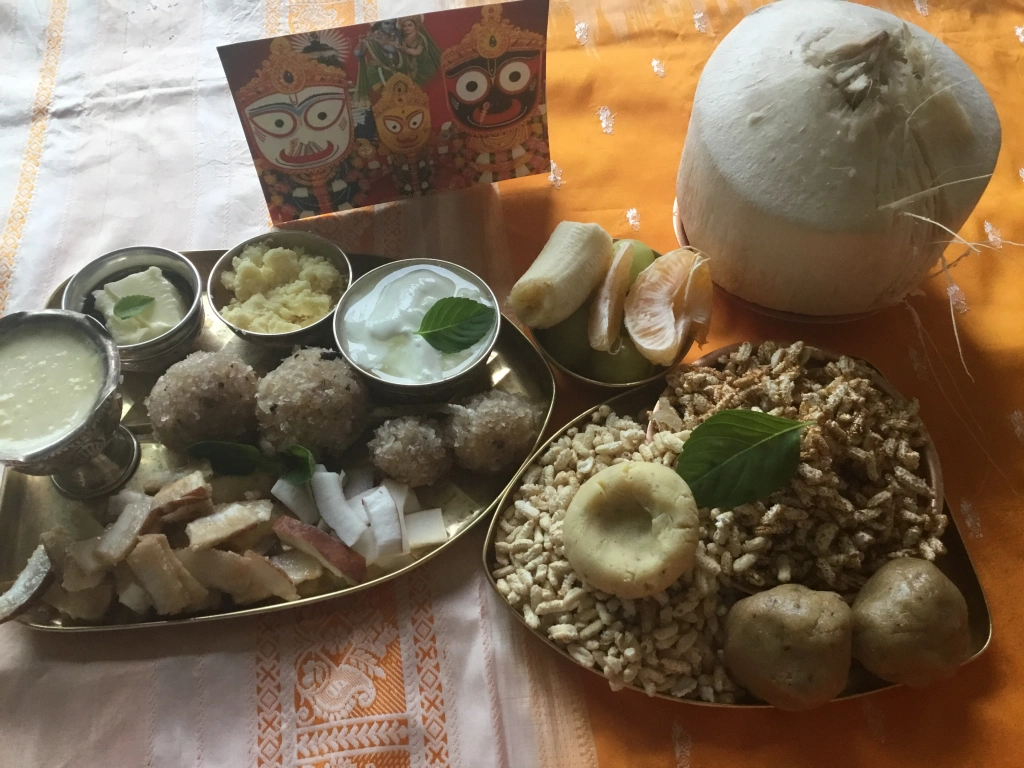
10. Sakala Dhupa
The morning meal offering, known as Sakala Dhupa or Raj Bhoga, takes place between 9am and 10am. This is one of the most important daily rituals in which a wide variety of food items are prepared and offered to the deities. These items include various black gram preparations such as Kanti, Enduri, Jhilli, Mathapuli, Hansakeli, Ada Pachedi, saga, Bhaja, Khechedi, and Kanika. The Pujapandas offer the bhoga to the deities with sixteen Upacharas (sixteen prescribed offerings).
11. Mailama
After the Sakala Dhupa is complete, the deities once again change their clothes. This time, they are adorned with fresh silken garments and floral ornaments by the Palia Pushpalaka servitors.
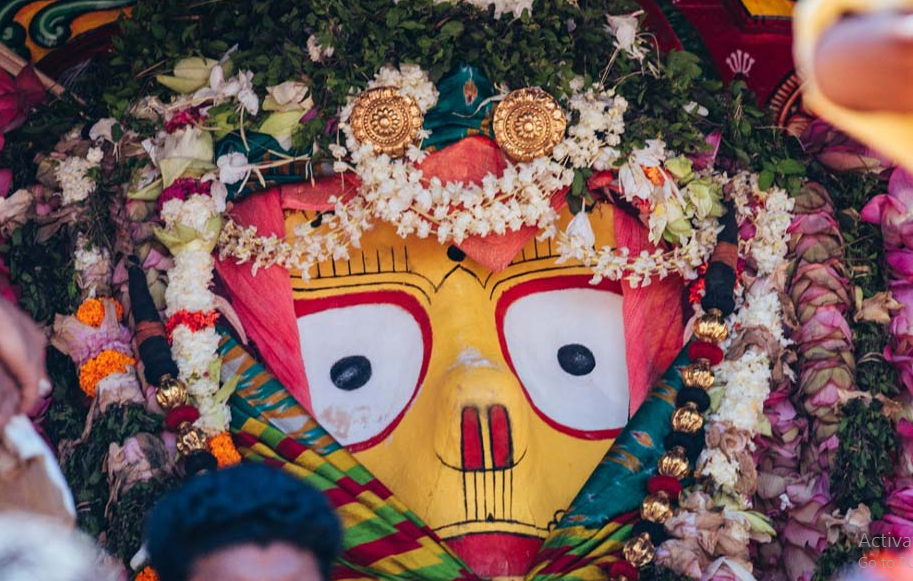
12. Bhoga Mandap Puja
At 11:30am, the Bhoga Mandap Puja takes place in the Bhoga Mandap hall, located behind the Garuda pillar in the Natamandap. Pujapandas offer this bhoga using Pancha Upacharas. This ritual is traditionally performed to facilitate pilgrims and institutions such as mutts, as well as to distribute Anna bhoga (rice offerings) to the general public. The bhogas offered here is primarily prepared to meet the needs of pilgrims and others.
13. Madhyahna Dhupa
In the afternoon, Madhyahna Dhupa takes place in a manner similar to the morning Sakala Dhupa. With sixteen Upacharas, a variety of dishes, including rice, curries, sweets and cakes, are offered. This ritual is performed in the sanctum sanctorum, near the Ratnasinghashan. After the bhoga is offered, lamps are also lit in front of the deities.
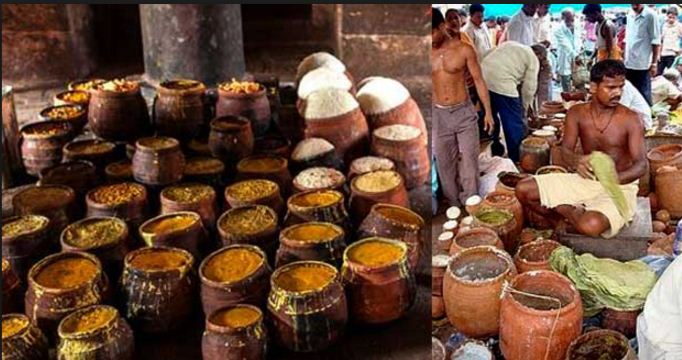
14. Sandhya Alati
At 6pm, the evening lamp offering, known as Sandhya Alati, is performed. This marks the beginning of the evening rituals. If there is no afternoon Pahuda (resting ritual), the Sandhya Alati takes place right after the Madhyahna Dhupa, followed by a change of clothing and floral garlands for the deities.
15. Sandhya Dhupa
From 6:30pm to 8pm, Sandhya Dhupa, the evening food offering, is performed in the same manner as the earlier Sakala and Madhyahna Dhupa. The bhoga items offered include watered rice, puli cakes, amalu, and other delicacies. During this ritual, three types of Alati, including camphor Alati and Jaya Mangal Alati, are performed to honour the deities.
16. Mailam and Chandanalagi
After the completion of the Sandhya Dhupa, the deities change their clothes once again. They are then anointed with sandal paste, mixed with camphor and saffron. This function is carried out by the Puspalaka sevakas, ensuring that the deities are refreshed for the night.
17. Badasinghara Besha
From 9pm to 10pm, the deities are clothed in their final attire for the night, known as Badasinghara Besha. This dressing involves special silken garments known as Baralagi Patta, which are finely embroidered. The deities are also adorned with floral ornaments, garlands, and basil leaves, making them look particularly beautiful in this attire. This besha is considered one of the most attractive and cherished of the daily outfits.
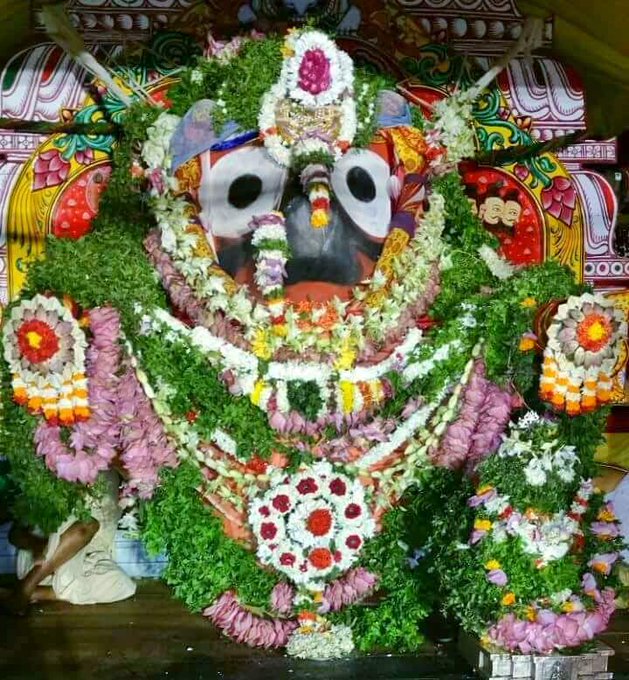
18. Badasinghara Dhupa
From around 10:30pm to 11pm, the final offering of the day, known as Badasinghara Dhupa, is presented to the deities. This offering includes watered rice, Kadalibara, Khiri and other delicacies. The Puja Panda servitors perform the puja with Pancha Upachara.
19. Khata Seja Lagi
At 11:30pm, the deities are prepared for sleep with the ritual known as Khata Seja Lagi. Their beds are made, and special offerings of green coconut, betels, and camphor are made before they retire for the night.
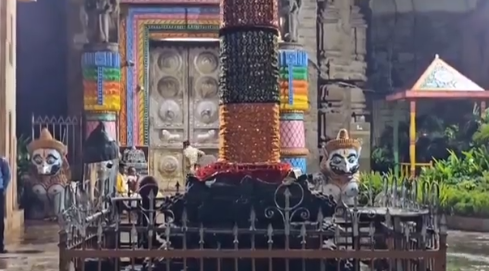
20. Pahuda
Finally, the last ritual of the day, known as Pahuda, involves the sealing of the temple doors. The temple doors are locked and sealed, with all but the required servitors and temple staff leaving the temple precincts. This marks the conclusion of the day’s worship and rituals, ensuring that the deities rest peacefully until the next morning.
By Patit Mandal, OP







































